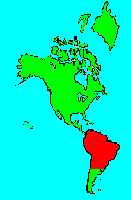SPECIES INFO
Northern helmeted curassow (Pauxi pauxi) is found in central to western Venezuela and also along the Venezuela Colombia border. This large guan is sexually dimorphic with a black male with a white belly and a white tipped tail. The female is brown with a white belly and black white tipped tail. Both sexes have an unusual pale growth on their forehead.
There are two subspecies: The nominate subspecies is found in north central and western Venezuela. The subspecies gilliardi is found along the border of Venezuela and Colombia.
This species is poorly known, but it is certainly endangered. The race gilliardi was rare as of 1967 (ICBP/IUCN Smithsonian Red Data Book 1992) and is either critically endangered or extinct.
This is listed as endangered in Bird Watch as published in 2011.The helmeted curassow genus (Pauxi) contains two species of birds. This genus is found in western Venezuela and eastern Colombia and in a distant area of Peru and Bolivia. These birds have an unusual, usually blue, growth on their foreheads. Both species are at best very rare, or perhaps endangered or even extinct.
Guan and Curassow Family (Cracidae Family) are a group of tropical birds found from Texas to Argentina in the New World. There were 38 species known in about 1960. (Monroe (1993) and Howard and Moore (2003) both listed 50 species.) Although members of the fowl group, these birds are unusual in that they nest in trees. Some species are brightly colored. Most examples are from about 20 to 36 inches in length.
Many members of these large chicken like birds are hunted for the table. Since they are also dependent upon forests, many of these species are extinct, potentially extinct, critically endangered, or rare.
Fowl group (Galliformes order) contains the various chickens and turkey-like birds of the world. There are about 240 different species of fowl known. Many of the wild species are endangered. Several species such as the domesticated chicken and turkey are main food sources in the world. Most fowl are grain eaters and spend a good portion of their life searching for food on the ground. Select species have been domesticated for their beauty and/or edibility, others are considered good game birds.
Aves contains about 8,650 different species of living birds known to science. Each year about one new species is discovered in some remote rain forest or remote island. In addition, scientists have been raising many subspecies to full species status which may raise the species count to 10,000. Birdlife recognizes 10,027 species as of 2011.
However, each year about one species goes extinct. The rate of extinction is increasing, and the rate of new discovery is decreasing, so that the number of bird species will soon begin to decline rapidly. Although different taxonomists would organize the birds differently, there are approximately twenty-seven orders of birds. These orders are broken down into about one hundred and fifty-five different families.
Recent research of the genetic structure of some of the shore birds and owls would indicate that the present organization of orders and families should have some modification.
The birds are a worldwide group of animals that are characterized by having the front limbs modified into wings that are used for flying. Perhaps the most unique feature of the birds is the feathers. These feathers are made up of a central support called a quill and a series of small filaments that are hooked together as barbs.
For many years it was believed that Archaeopteryx discovered in Bavaria was the oldest bird from about 150 million years ago. However, in l986, Sankar Chattterjee, a Texas paleontologist, reportedly discovered a bird in the genus Protoavis that lived about 225 million years ago.
When this project was begun in 1978, we used Austin & Singer for bird taxonomy. Since then, we have adopted many changes, but have kept some older concepts that are still found widely in the literature. Recently, we have used Clements and Howard & Moore. Very recently, we have used Monroe and Sibley for the higher taxonomy of the perching birds.
Backboned Animals (Phylum Chordata) are the most advanced group of animals on earth. These animals are characterized by having a spinal cord or backbone. Most members have a clearly defined brain that controls the organism through a spinal cord. Fish, amphibians, reptiles, birds, and mammals are in this phylum.
Currently, some taxonomists believe that the fish should be divided into two groups (sharks and regular fishes) and that there are some other primitive groups in the phylum such as hagfish or lampreys.
Animal Kingdom contains numerous organisms that feed on other animals or plants. Included in the animal kingdom are the lower marine invertebrates such as sponges and corals, the jointed legged animals such as insects and spiders, and the backboned animals such as fish, amphibians, reptiles, birds, and mammals.

